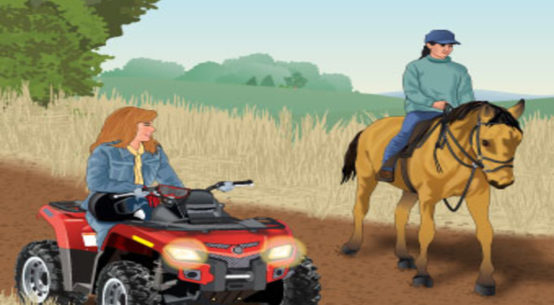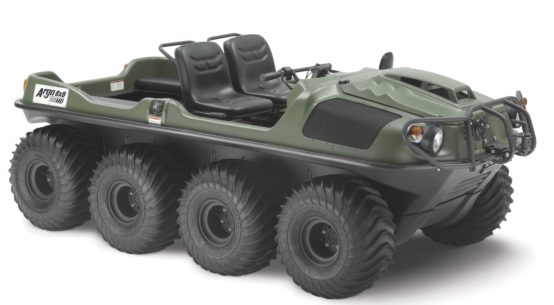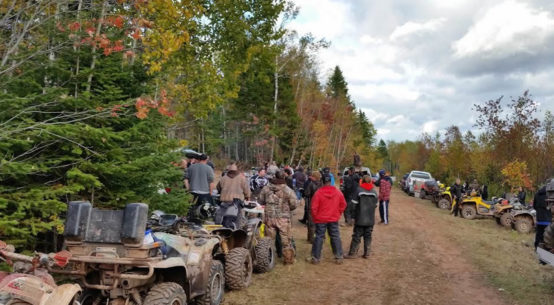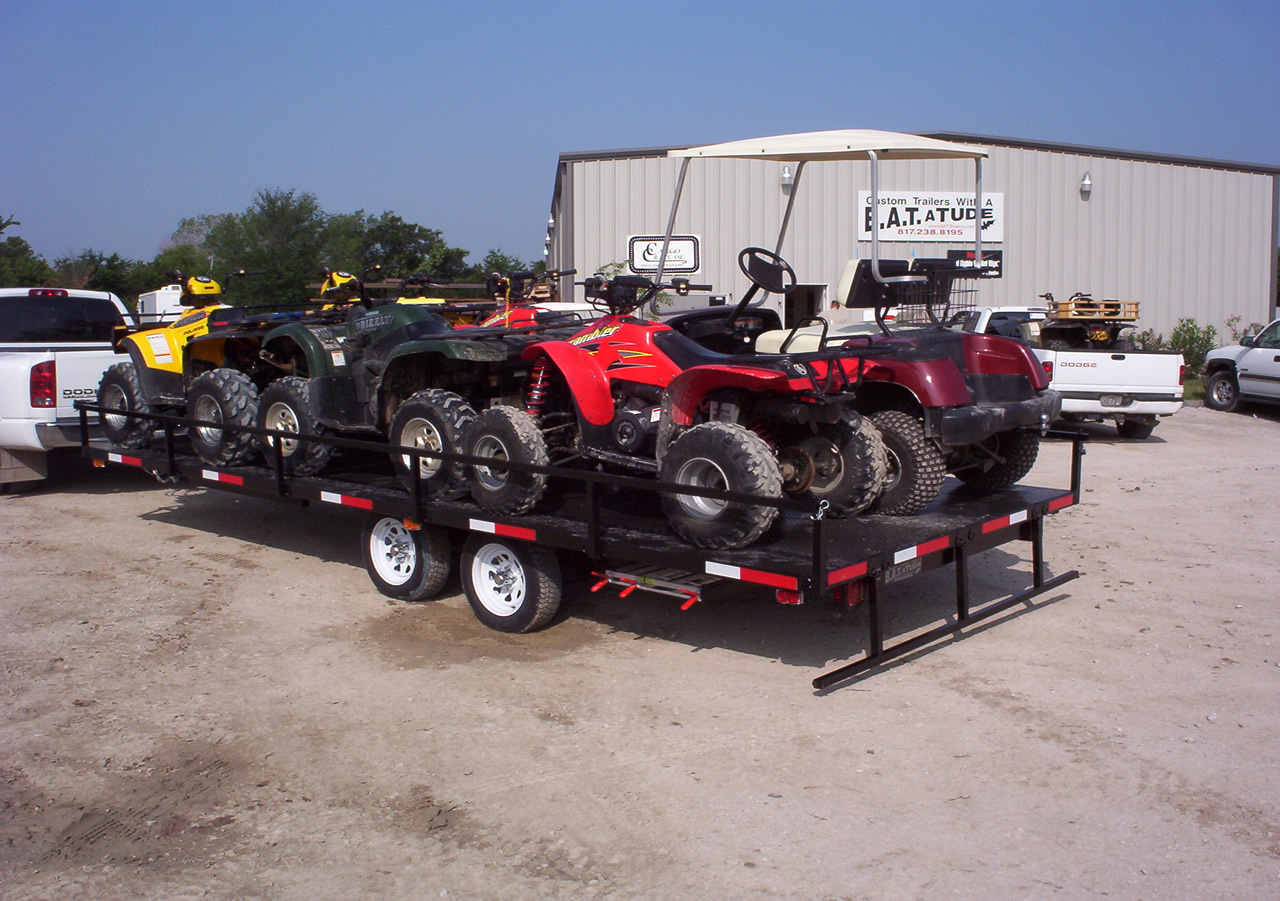
Connecting your trailer to your vehicle
Be sure that the towing ball on your vehicle is the same size as that required for your trailer. It is not a pleasant experience to be driving down the road and hear your trailer bump you as you pull to a stop. Worse yet is seeing it go on past you. Trailer balls are only $7 to $10, so it is well worth the investment.
The chains on the trailer are provide to keep the trailer with you even if the ball somehow becomes disengaged. Put the chains through the loops on your trailer mount and then hook the chain again with the s hook at the end of the chain.
The electrical connection is of equal importance for your safe journey. Make sure that your trailer has the same electrical connection as your vehicle. Conversion units are available at places like Walmart that permit the interface between to variant attachment pieces. Trailer wiring usually comes with ample wire to attach to your vehicle. Just be sure that the slack is not able to drag on the ground. You may twist it around the tongue of the trailer a few times to be sure that you are okay. All you need is enough wire to reach the plug.
Once connected, turn on your lights, check the blinkers in both directions and check the brake lights. When you are pulling a trailer you want all your fellow travelers to know exactly what you are doing as far in advance as possible. If your blinkers and break lights do not work properly, do not proceed until you have corrected this problem. It may be as simple as changing the light bulb in the trailer or the fuse under the dash of your car. Please consult a professional if you cannot do this yourself.
Loading your ATV
There are many different types of trailers that will accommodate an ATV. Often snowmobile trailers are used for that purpose. ATVs can even be transported in the back of a pickup truck or a van. However, it is highly recommended that you use a trailer that is designed for transportation of an ATV to minimize the risk of injury or accident.
Make sure that your trailer is securely attached to your vehicle prior to loading your ATV. Otherwise you risk tipping the trailer to the front or rear. One of the handiest tools you can get for your trailer is a tongue wheel or stand. I highly recommend them. They will save your back, if nothing else. Just be sure that you put the wheel/stand up after you have attached the trailer to the vehicle.
Most ATV trailers will have a ramp that can be lowered and permit the simple loading of the ATV. Some trailers will tilt to permit the access without a ramp. The tilting type utility trailer may be good for hauling a lawnmower, but they are not generally engineered with sufficient strength to accommodate a 300 to 500 pound ATV. If you are presently employing, or planning to employ one of these trailers, please consider the risks to yourself and your ATV carefully.
Lower the ramp into the appropriate position.
When loading your ATV you need to keep in mind that your trailer will ride much more smoothly if the weight is centered just slightly to the rear of the axle. This will decrease the tongue weight on your hitch. While many 2″ towing balls are certified to hold up to 2000 pounds weight, it is not recommended that you try to achieve that limit. If you can balance the weight on your trailer so that it is very easily lifted into place on your trailer hitch you will maximize the wear and tear not to mention weight on your towing vehicle.
When you approach the ramp be sure your ATV is in first gear (the lowest gear) so that you can climb up the ramp without difficulty.
Before you dismount the ATV turn off the motor and remove the key and then LOCK THE BREAKS on the ATV.
Tying Down the ATV
Each ATV should be tied down using straps, not ropes that will allow the machine to be cinched down as tight as possible. Ratchet type straps are available that permit you to clamp them down quite tightly. If these have a weakness it is that they tend to wear out rather quickly if you use them often. Tie-down straps generally come with hooks at each end. One end will have a short strap with a clamp. Place the short strap at the top and the long end of the strap on the bottom.
Find a place to hook the strap to your machine. If you have a utility type ATV the racks in the front and rear will work fine. If you have a sport type ATV you may use the front bumper or handle bars in the front and there is usually a rear bar beneath or behind the seat so that you can put the strap on at that location.
It is best if you use 4 straps, one on each side front and back. In cases where you have multiple machines on the same trailer you may be limited to one strap for the front and on the back.
Choose a location on the trailer to hook the long end of the strap. The site you choose should be as close to the location on the ATV as possible. You need to be sure that the site you select will not permit the hook on the strap to slip while in transit. Many ATV trailers are built with strap hook holders to facilitate such use.
Once the strap is hooked on both ends, remove the slack from the strap by pulling the excess through the clinch holder on the strap. .
Now here is a secret that will help you successfully tighten your machine to the trailer. If you put the short end of the strap at the top on the ATV you will be able to put your foot on the excess strap while holding the other end in your hand and put your full weight on the strap at the same time compressing the shock absorbers. Your ATV will not be tight enough if you simply tighten the strap without compressing the shock absorbers. If necessary, have someone else sit on the ATV and lean on the corner to be compressed with the strap.
When done properly, the ATV will show pressure on the tires, as though the tires are low or heavily weighted. This is good.
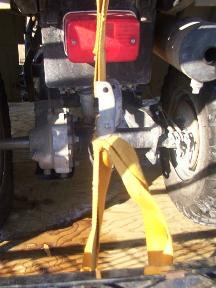 Be sure you test each tie-down strap to make sure that it is securely in place, top and bottom. When you are satisfied this is true do a half hitch around the bottom part of the strap right next to the clinch and pull it tight to further assure that the clinch will not slip while in transit. This slippage will happen if you do not do this.
Be sure you test each tie-down strap to make sure that it is securely in place, top and bottom. When you are satisfied this is true do a half hitch around the bottom part of the strap right next to the clinch and pull it tight to further assure that the clinch will not slip while in transit. This slippage will happen if you do not do this.
Most tie down straps have many feet, if not yards, of excess strap. When this is the case it is recommended that you loop the remaining length of strap so that you can tie this remaining strap loop into a single overhand knot. Don’t get too fancy with this knot. The idea is to keep the remaining piece of strap from dragging below or behind the trailer.
The final test will be to shake your ATV and it should not move forward or backward at all without the trailer moving a similar distance from your effort. It should be as though the two units are now one. If not, when completed with the tie down you may raise the ramps and secure them into place and then you are off for a day of fun and enjoyment.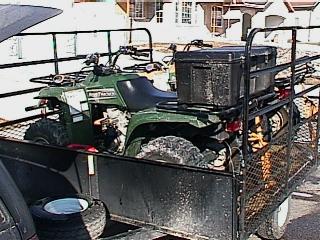
On the Road
There are several thing that you should keep in mind as you drive your rig down the road.
- Your breaking distance is going to be much greater with the added weight of the trailer and ATV(s) on behind you.
- You need to be alert to the position of all traffic on the road ahead behind and to both sides, so you have as much time as possible to react and move around obstacles.
- Changing lanes should be done slowly and intentionally with plenty of notice to other drivers that you are coming over.
- One of the most common causes to trailer displacement is swerving quickly on the road. This can even cause your vehicle to be turned over from the inertia of the trailer behind you.
- If you trailer begins to fishtail behind you, slow down.
- The added weight of the trailer and ATVs will also make climbing hills more difficult and will be much below the normal speed you are able to climb hills. Stay to the right so that other motorists can pass you without obstructing traffic.
- Maintain speeds that will permit you to have complete control of your vehicle and trailer at all times.
Unloading your ATV
- Put on your boots, helmet, goggles, and gloves.
- Lower the appropriate side ramp to permit you a forward removal of the ATV. Remove the tie-downs and place them in your vehicle to prevent their loss while you are out riding.
- Start your ATV and permit it to idle just a moment or two to insure that it will not stall out while you are on the ramp.
- Remove the break lock and move forward carefully and cautiously as you pull down the ramp.
- Stop and turn off your ATV.
- Return the ramps to the upright and locked position.
- Make sure that you have all your gear and map with you before you head out.
- Have a great and safe time.
Trailer Maintenance
Fortunately maintaining your trailer is very simple. There are very few things that can go wrong, but most of us have seen situations when someone procrastinated the trailer maintenance too long leaving the trailer at the side of the road… as a monument of failure to plan and prepare.
- Be sure that the wheels are greased each year.
- Inspect the tires often to be sure that they are not worn.
- Carry a spare tire, lug wrench and jack that will work with your trailer with you. Even if you have good new tires, there is no guarantee; road damage may ruin a tire. Just a note: make sure your car jack will work with your trailer, or get a jack that will.
- Check the taillights each time you use the trailer.
- You can also carry a can of “spare tire” to inflate the tire, when and if needed.
- Put oil or grease on the hinges if they are present on your tailgate or side ramps.
Image taken from BAT Custom Trailers, visit them for customized, personalized, and commercial trailers. Located in Forth Worth, TX.

